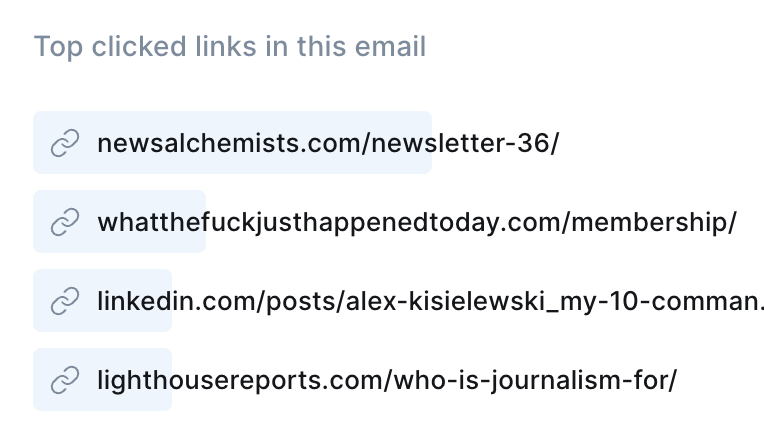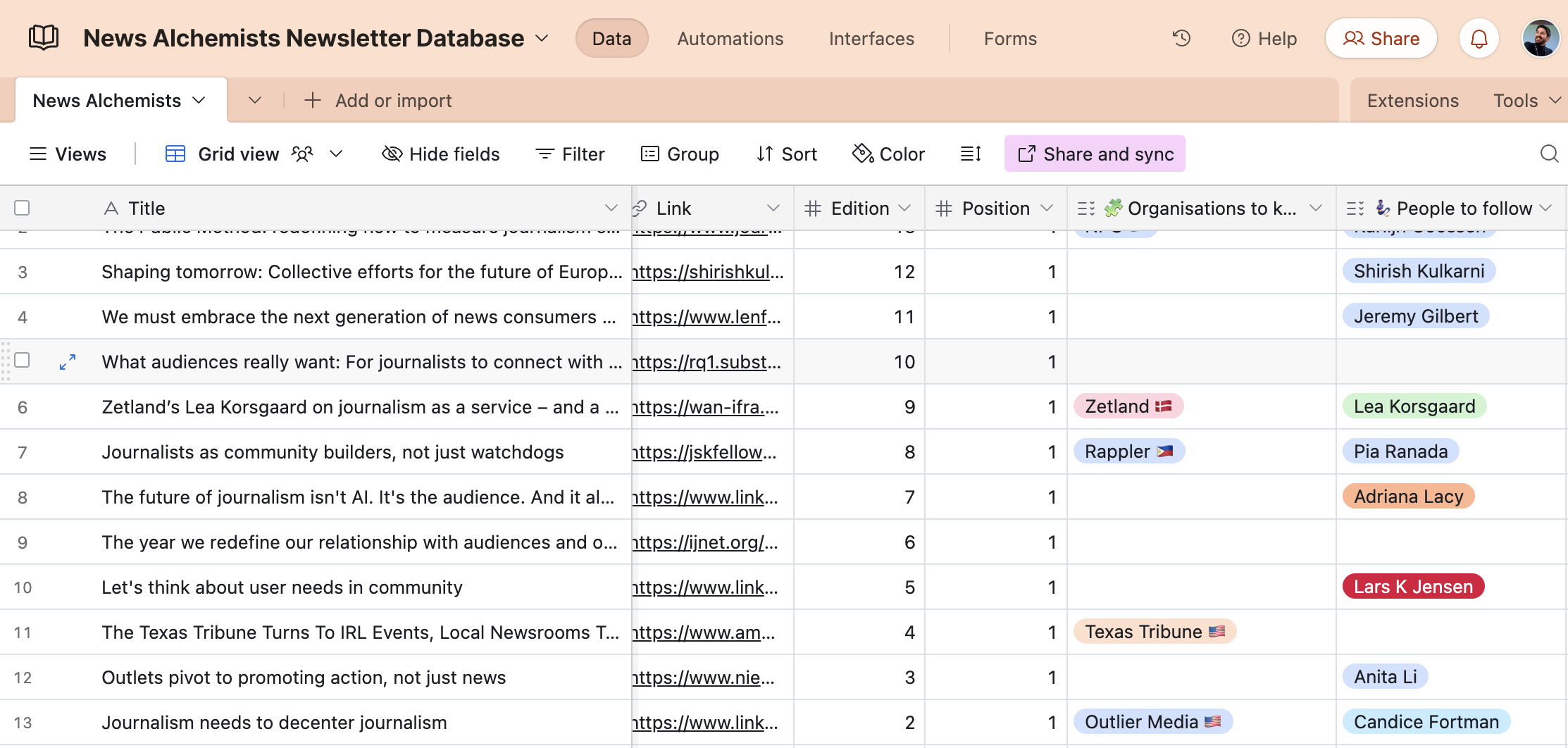🔶 News Alchemists #37: "What is so essential about news?"
Hello and welcome back to the News Alchemists newsletter!
I experienced a significant amount of FOMO over the last few days, seeing my timeline full of posts and photos from two events I really enjoyed last year: the b° future festival in Bonn and the amazing Media Party in Buenos Aires. Did you go? How was it? What have you learned? Please do share and help me ease the FOMO.
(And that's nothing compared to the FOMO I will experience at the end of November for not being again at Splice Beta in Chiang Mai. Are you going? No, don't tell me, I will hate you.)
Last week I said that today I was going to share what I'm learning from the feedback you sent through the reader survey. But even after spending hours reviewing your responses, I feel that I need more time to assess what is actually relevant for you vs what is just useful to me to improve this space but not interesting for you to read about.
For now, I will start by acting on one of the most recurring suggestions: shorter intros 😬
Before we move to the links, check out this case study by Opinary, a company that helps publishers reach, understand and convert their target audiences – and the generous sponsor of this week's newsletter:
Yahoo shows what a reader forum should look like today
The “Poll of the Week” is a weekly article format on Yahoo UK that allows readers to vote on current topics ranging from politics and social issues to pop culture and lifestyle trends. It offers a quick way for the broad audience to share their opinions and see how others feel about trending debates. An analysis from the editorial team, published later in the week, shares reflections on the readers polls’ results, allowing the Yahoo community to revisit how...
Today's links are about rethinking the values that drive news coverage, doing user needs right, innovating your revenue streams, and much more. Enjoy the read, and see you next week! 👋
P.S.: The most-clicked link in last week's newsletter was not one of the seven links, but the membership page of 'WTF Just Happened Today' that I encouraged you to copy study in depth. I'm so proud of you.

1. What is so essential about news? 👉 LINK
Last week I had an inspiring conversation with 🧞Sarah Alvarez, whose work as founder and former editor-in-chief of Outlier Media I have long admired. (Earlier this year, she moved to Temple University as Chair in Journalism Innovation.)
In her own newsletter, Understated, Sarah provides ideas "on how to find, share and understand the information we need to stay engaged without being overwhelmed". In this edition, she looks at the values that conventionally drive newsmaking (things like timeliness, prominence, novelty, etc.), arguing they are well due for a refresh: "These values or criteria should be more about what any particular piece of news can do for a person or a community and less about how it might attract attention."
Do I even need to tell you how much I agree? Also:
"It seems like all of us, in newsrooms and journalism schools, should be challenging everything we know right now and then changing what doesn't check out." 🗣️🗣️🗣️
(LOL to the story in the article about a Norwegian sociologist who, in the '60s, contributed to developing a taxonomy of factors that drive news coverage... and then stopped speaking to the media for decades because he was so pissed that they didn't even understand that he was describing, and in part criticising, how things were done, not how things should be done. 🤦)
2. Doing User Needs right: The Bureau of Investigative Journalism share their secrets 👉 LINK
The 'user needs' model is widely adopted across the industry (though not enough), but some organisations struggle more than others to implement it – for example, investigative newsrooms focused on accountability and holding power to account rather than serving individual user needs. That's why The Bureau's experience adapting the model to their specific circumstances is especially interesting.
🧞Oliver Kemp, TBIJ’s audience editor: "The first step is to talk directly to your audience. These conversations can take many forms – surveys, interviews, focus groups, or even informal chats – but the goal is the same: to hear in their own words what they value, what they struggle to find elsewhere, and how your journalism can serve them better. This insight becomes the foundation for tailoring the model to fit your unique context."
3. What I learned in the first five years of Platformer 👉 LINK
"When I quit my job to launch Platformer, the idea seemed novel enough that the New York Times covered it. Today, we take departures like these for granted. In fact, once a reporter at a mainstream outlet achieves a certain level of prominence, people now ask them why they stay."
Don't miss this honest and inspiring account that 🧞Casey Newton wrote five years after leaving his full-time job at The Verge to launch 🧩 Platformer, which today sustains itself thanks to thousands of paid subscribers and a thriving advertising business, while employing five people, Casey included.
4. If the product is news 👉 LINK
In this excellent article published by the News Product Alliance, 🧞Mariah Craddick (executive director of product at The Atlantic) makes a compelling case for tighter newsroom and product collaboration:
"With funding nearly always limited or a restraint, news organizations will need to:
- be thoughtful about how to test and validate ideas with their audience before pouring more resources into projects;
- be attuned to who their readers, supporters, and followers are, to understand what they can offer that will be of relevance and of interest;
- consider the experience of interacting with their journalism and ways that audiences can engage with and support it;
- get more experimental about what “journalism” even means, rethinking traditional storytelling tools, delivery methods, and story formats.
This means that, in order for newsrooms to truly be successful in this next era, to compete for attention, and to be relevant to people’s lives — they can no longer operate as if news is not a product."
(This article is the first in a six-part series. The second instalment, about Zetland's approach to product–newsroom integration, has also been published.)
5. Coffee, pozole and a good story: a Q&A with Big Bend Sentinel 👉 LINK
Last March, 🧞Max Kabat wrote a LinkedIn post that, to this day, is one of the most-clicked links in this newsletter: Local journalism is in the wrong business. In this interview with the Listening Post Collective, Max shares some excellent advice for any traditional or emerging news outlets looking to innovate their revenue streams.
💬 "If the goal of local journalism is to bring people together and build community through news and information, what might an experiential product look like? What if a weekly paper could have a way of engaging the community every day?"
6. Greek investigative outlet Solomon builds one-on-one reader relationships and pathways for direct support 👉 LINK
Meet 🧩 Solomon, an investigative outlet founded in Greece in 2016 that joined the International Press Institute's 'Transition Accelerator' to strengthen the relationship with its audience. After revamping their newsletter strategy and experimenting with ways to involve readers directly in their storytelling, engagement is up, donations are up, and readers eagerly take time to fill in surveys to share their experience and contribute to the reporting.
7. Journalism has many roles. It’s time to embrace the role of convener. 👉 LINK
If you've been following this newsletter since the beginning, you might have read the headline and thought: "Wait, you've shared this link before. 🤔" Well, a) you're right, and b) it's not a fail of my memory, it's intentional: from time to time, I will re-share links from old editions that didn't get as much love as I thought they deserved (based on # of clicks), or that I want to make sure you don't miss if you subscribed to the newsletter after they were shared.
In this piece, the American Press Institute challenges us to think of media as "a force for social connection, a convener of people across differences and a facilitator for what to do after the facts are laid bare."



Member discussion